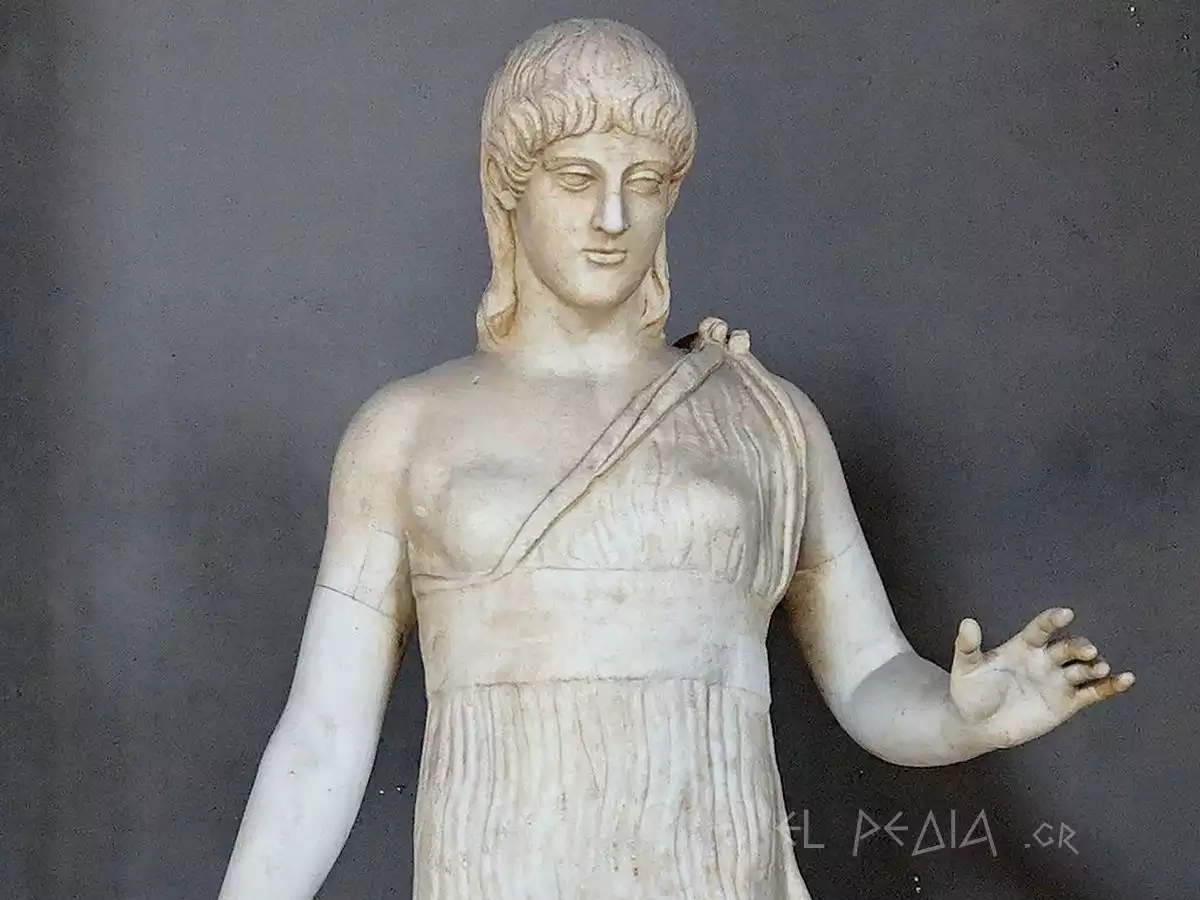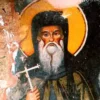
Atalanta is one of the most iconic figures of ancient Greek mythology, renowned for her exceptional prowess in hunting and athletics. Born in Arcadia or Boeotia, Atalanta was the daughter of King Iasus (or Schoeneus in the Boeotian version of the myth). According to tradition, her father, desiring a male heir, abandoned her as an infant on Mount Parthenion, where she was raised by a bear until hunters found her. As she grew up, Atalanta became an exceptional huntress, devoted to the worship of Artemis. Her fame was established with her participation in the hunt for the Calydonian Boar, where she managed the first critical wound on the beast.
Atalanta’s story includes multiple episodes that highlight her exceptional skill and strength. Refusing to marry, she set the condition for her marriage as the victory of her suitors in a footrace against her, with the prize being marriage and the punishment being death for the losers. Many young men lost their lives in the attempt until Hippomenes (or Melanion) managed to defeat her with the help of Aphrodite, who gave him three golden apples from the garden of the Hesperides. By throwing the apples during the race, he managed to delay Atalanta and win the race and her hand.
The Birth and Upbringing of Atalanta
The birth of Atalanta marks the beginning of one of the most fascinating myths of ancient Greek literature, as she is a heroine who defied the social conventions of her time. Born in Arcadia, according to the most prevalent version of the myth, Atalanta was the daughter of King Iasus and Clymene. Her father, disappointed at not having a male heir, decided to expose the infant on Mount Parthenion, an act reflecting the patriarchal structures of ancient Greek society.
Atalanta’s survival is attributed to a female bear, which, according to myth and tradition, nurtured and suckled her until hunters discovered her (Dowden). This symbolic connection with the wild and the world of hunting profoundly shaped the personality and future path of the heroine. The hunters who found her raised her, teaching her the art of hunting and survival in the wild, skills that would later prove crucial for her development.
The young Atalanta, growing up in the natural environment of the mountain, developed exceptional physical abilities and a deep connection with the goddess Artemis, the protector of hunting and virginity. As her fame spread throughout Greece, many admired her ability to survive alone in the wild, hunt with unparalleled skill, and defend herself against any threat. Her exceptional hunting ability and dedication to the goddess Artemis made her a unique case in ancient Greek mythology, where female figures were rarely portrayed with such autonomy and strength.
Atalanta’s childhood and adolescence were marked by the rejection of conventional female roles of her time. Instead of preparing for marriage and family life, as was customary for young girls, Atalanta chose to dedicate herself to the art of hunting and the development of her martial skills. This choice, reflecting a deeper resistance to established social roles, would decisively shape the course of her life and make her one of the most memorable figures in Greek mythology.
The Hunt for the Calydonian Boar
The hunt for the Calydonian Boar is one of the most iconic episodes in Atalanta’s story, where the heroine demonstrated her exceptional hunting prowess. Her participation in this famous hunt marked her entry into the circle of prominent heroes of antiquity. The myth begins when the king of Calydon, Oeneus, offended the goddess Artemis by failing to offer her a sacrifice during the harvest.
The enraged goddess sent a gigantic wild boar to ravage the land of Calydon. The beast, with unprecedented size and unimaginable strength, devastated the crops and killed anyone who dared to confront it. Faced with this threat, Meleager, the son of Oeneus, gathered the bravest heroes from all over Greece for a great hunt that would go down in history (Boardman).
Atalanta, despite the initial objections of some men who believed that a woman had no place in such a dangerous mission, managed to prove her worth in the most impressive way: during the confrontation with the fearsome beast, the fearless huntress inflicted the first critical wound on the Calydonian Boar with a skillful shot, proving that the art of hunting knows no gender restrictions.
Atalanta’s participation in the hunt for the Calydonian Boar was a turning point in ancient Greek mythology, as for the first time a woman was recognized as equal to men in such a dangerous and significant mission. Her success earned the admiration of Meleager, who awarded her the spoils of the hunt as recognition of her bravery, an act that provoked the anger of his uncles and led to tragic events.
The story of the Calydonian Boar and Atalanta’s role in it has been preserved through numerous artistic representations in ancient Greek art, from vase paintings to reliefs, highlighting the significance of the episode in ancient Greek consciousness and its influence on shaping perceptions of gender roles in ancient Greek society.
The Footrace and the Golden Apples
The legendary footrace of Atalanta constitutes one of the most characteristic episodes of ancient Greek mythology, intertwining elements of human desire, divine intervention, and fateful irony. Atalanta’s unmatched speed, combined with her unparalleled beauty, attracted a multitude of suitors, despite her categorical refusal to marry.
In her effort to maintain her independence, Atalanta set an apparently impossible condition: she would marry only the one who could defeat her in a footrace. The terms of the race were relentless – the winner would gain her hand, but the losers would pay with their lives. Many young men, lured by her beauty and the Greek tradition of ritual trials, lost their lives in the attempt to win her (Barringer).
Atalanta’s fate changed with the appearance of Hippomenes (or Melanion, according to other versions of the myth), a young man who decided to face the challenge with a different strategy. Recognizing that Atalanta’s speed was insurmountable, Hippomenes turned to the goddess Aphrodite for help, who offered him three golden apples from the garden of the Hesperides.
During the race, Hippomenes used the apples with exceptional skill and strategic thinking: he threw each apple at different points along the course, carefully calculating the timing and distance. Atalanta, despite her initial determination, could not resist the allure of the golden apples, delaying to collect them. This delay gave Hippomenes the advantage he needed to win the race.
Hippomenes’ victory marked a new phase in Atalanta’s life, as the heroine was forced to honor her vow and marry the winner. However, the story does not end here, as the couple, in the pride of their passion, defied the sanctity of a temple, provoking the wrath of the gods. Their punishment was their transformation into lions – a transformation that, paradoxically, preserved their eternal union in the animal kingdom.
Atalanta’s Enduring Myth in Ancient Greece
The ancient Greek mythology of Atalanta still captivates scholars and enthusiasts. Her character—a potent blend of heroism and fierce independence—forged a powerful archetype of female strength in the ancient Greek world, a world that is, despite being vastly different from modern England, still so similar to our world in themes of individual agency that it would be ridiculous to try to deny those parallels. That the power of artistic and cultural exchange could endure for centuries across the divide of space and time—that, quite simply, is the magic of art. Atalanta’s essential position within the mythological pantheon is represented well by the variable art forms of classical antiquity. From vases to vases, sculpted reliefs to painted reliefs, even in frescoes, Atalanta’s appears in multiple forms across as many media, showing the many facets of her nature and what the ancient Greeks considered the truly mythical qualities of her story and the accomplishments in it. And it seems all the more a window into the Greek mind for its not being a single, static portrayal, offering instead the dynamic picture of a really visible, really physical part of their world. Atalanta’s singular contribution to ancient Greek mythology is her defiance of conventional gender roles. She is one of the very few female characters in Greek mythology with personal autonomy and a happy ending. On the surface, Atalanta’s life story seems to be yet another myth in which a woman is punished for daring to be different and for thinking she can live apart from men. But Atalanta’s story is complicated. Even as it narrates her autonomy, it holds up for admiration not just Atalanta’s physical prowess (with which she is unique among female figures in Greek mythology) but also her personal independence. And it does all this while simultaneously warning against the price one may pay for such daring.
Atalanta’s relationship with the goddess Artemis—who presides over the hunt, outdoor life, and all things wild—underscores the viable alternatives available to women in ancient Greece: living as a chaste, unattached, and independent person, or as an obedient wife and mother (if one is to believe all the so-called “ideal” portraits of women’s lives). When Atalanta concludes that she cannot live without companionship, she risks a terrifying metamorphosis. Atalanta does not and cannot become a lioness without also transforming her husband into one. The latter part of the story hints at the consequences of yielding to the desire for “company.”
The influence of Atalanta’s myth stretches well past the limits of ancient Greek mythology into the literary and artistic creations of later ages. Her tale still gives impetus to contemporary artists and writers, who delve into the forever novel and sought-after territory of their myth’s meaning and assess its relevancy to modern understandings of gender roles and the ancient baselines of human nature. Atalanta’s story serves as a potent reminder that Greek myth isn’t just a dusty old book of stories, but really one of humanity’s first and best attempts at self-portraiture.
From Myth to Timelessness
The myth of Atalanta remains one of the most characteristic examples of the complexity of ancient Greek mythology. Her story reflects the deep understanding of the ancient Greeks of human nature and social structures. Atalanta, as a figure that transcends the established boundaries of her gender, symbolizes resistance to social constraints and prejudices.
Atalanta’s legacy in the global cultural heritage is invaluable. Her influence extends beyond the confines of ancient Greek mythology, inspiring artists, writers, and thinkers in various eras. The timeless appeal of her myth is due to its multi-layered nature, touching on themes such as freedom of choice, the power of will, and the consequences of hubris.
elpedia.gr
Bibliography
Barringer, J.M. “Atalanta as Model: The Hunter and the Hunted.” Classical Antiquity 15, no. 1 (1996): 48-76.
Boardman, John. “Atalanta.” Art Institute of Chicago Museum Studies 10 (1983): 2-19.
Dowden, Ken. “Myth, Heritage, Localisation: Atalanta—a Case Study.” Gaia 24 (2021).

